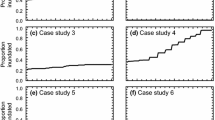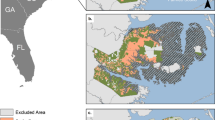Abstract
The growing cost of climate-driven coastal impacts requires an improved understanding of how coastal populations engage with adaptation decisions. While many studies explore factors driving coastal adaptation, generally, few evaluate how residents consider relationships between in situ, protective adaption vs. retreat from at-risk areas. What is the relationship between residents’ exposure, perceptions of climate trends, and concerns about the future? How do these factors influence openness to different adaption strategies? Are these strategies considered to be progressive—where protection is indexed to minor threats and retreat occurs when protection measures fail—or are these dichotomous choices? We apply structural equation modeling to evaluate these decision pathways using a 2017 household survey in North Carolina’s (USA) Albemarle-Pamlico Peninsula (n = 147). Our results reveal that residents commonly view protection and retreat as mutually exclusive, rather than progressive, methods for reducing risk, and that their preferences are correlated with different understandings of climate threats.





Similar content being viewed by others
References
Adger WN (2009) Social capital, collective action, and adaptation to climate change. Econ Geogr 79(4):387–404
Adger, W Neil, Irene Lorenzoni, and Karen L. O’Brien. 2009. “Adaptation now.” In Adapting to climate change: thresholds, values, governance, edited by W. Neil Adger, Irene Lorenzoni, and Karen L. O’Brien, 1–22. Cambridge University Press
Aerts JCJH, Botzen W, Clarke KC, Cutter SL, Hall JW, Merz B, Michel-Kerjan E, Jaroslav M, Surminski S, Kunreuther H (2018) Integrating human behaviour dynamics into flood disaster risk assessment. Nat Clim Chang 8(3):193–199
Armitage CJ, Conner M (2001) Efficacy of the theory of planned behaviour: a meta-analytic review. Br J Soc Psychol 40(4):471–99. https://doi.org/10.1348/014466601164939
Babcicky, Philipp, and Sebastian Seebauer. 2018. “Unpacking protection motivation theory: evidence for a separate protective and non-protective route in private flood mitigation behavior.” Journal of Risk Research 0 (0): 1–18
Bardsley DK, Hugo GJ (2010) Migration and climate change: examining thresholds of change to guide effective adaptation decision-making. Popul Environ 32(2):238–262
Bartlett, James E, Joe W Kotrlik, and Chadwick C Higgins. 2001. “Organizational research: determining appropriate sample size in survey research” 19 (1): 43–50
Behr JG, Diaz R, Mitchell M (2016) Building resiliency in response comprehensive planning in Hampton roads. Virginia News Letter 92(1):1–6
Bhattachan A, Emanuel RE, Ardón M, Bernhardt ES, Anderson SM, Stillwagon MG, Ury EA, BenDor TK, Wright JP (2018b) Evaluating the effects of land-use change and future climate change on vulnerability of coastal landscapes to saltwater intrusion. Elementa 6
Bhattachan A, Jurjonas MD, Moody AC, Morris PR, Sanchez GM, Smart LS, Taillie PJ, Emanuel RE, Seekamp EL (2018a) Sea level rise impacts on rural coastal social-ecological systems and the implications for decision making. Environ Sci Policy 90(December 2017):122–134
Binder SB, Baker CK, Barile JP (2015) Rebuild or relocate? Resilience and postdisaster decision-making after hurricane Sandy. Am J Community Psychol 56(1–2):180–196
Black R, Neil Adger W, Arnell NW, Dercon S, Geddes A, Thomas D (2011a) The effect of environmental change on human migration. Glob Environ Chang 21(SUPPL. 1):S3–S11. https://doi.org/10.1016/j.gloenvcha.2011.10.001
Black R, Bennett SRG, Thomas SM, Beddington JR (2011b) Climate change: migration as adaptation. Nature 478(7370):447–449
Bollen KA, Scott Long J (eds) (1993) Testing structural equation models. Sage Publications
Botzen WJW, van den Bergh JCJM (2012) Risk attitudes to low-probability climate change risks: WTP for flood insurance. J Econ Behav Organ 82(1):151–166
Bowen NK, Guo S (2012) Structural equation modeling. Oxford University Press, Edited by Tony Tripodi
Brettell CB, Hollifield J (2015) Migration theory: talking across disciplines. Routledge, New York, NY
Brown, Oli. 2008. “Migration and climate change.” IOM Migration Research Series
Bubeck P, Botzen WJW, Kreibich H, Aerts JCJH (2013) Detailed insights into the influence of flood-coping appraisals on mitigation behaviour. Glob Environ Chang 23(5):1327–1338
Bubeck P, Botzen WJW, Kreibich H, Aerts JCJH (2012a) Long-term development and effectiveness of private flood mitigation measures: an analysis for the German part of the river Rhine. Nat Hazards Earth Syst Sci 12(11):3507–3518
Bubeck P, Botzen W, Aerts JCJH (2012b) A review of risk perceptions and other factors that influence flood mitigation behavior. Risk Anal 32(9):1481–1495
Bubeck P, Wouter Botzen WJ, Jonas L, Aerts JCJH, Thieken AH (2018) Insights into flood-coping appraisals of protection motivation theory: empirical evidence from Germany and France. Risk Anal 38(6):1239–1257
Castles S (2003) Towards a sociology of forced migration and social transformation abstract. Sociology 77(1):1–18
Church AH (1993) Estimating the effect of incentives on mail survey response rates: a meta-analysis. Public Opin Q 57(1):62–79
de Vries Daniel H, Fraser JC (2012) Citizenship rights and voluntary decision making in post-disaster U.S. floodplain buyout mitigation programs. Int J Mass Emerg Disasters 30(1):1–33
Dillman, Don A., J.D. Smyth, and L.M. Christian. 2008. Internet, mail, and mixed-mode surveys: the tailored design method. 3rd Editio. Hoboken., NJ: Wiley
Frankhauser S (1995) Protection versus retreat: the economic costs of sea-level rise. Environ Plan A 27(2):299–319
Grace JB, Bollen KA (2005) Interpreting the results from multiple regression and structural equation models. The Bulletin of the Ecological Society of America 86(4):283–225
Grothmann T, Patt A (2005) Adaptive capacity and human cognition: the process of individual adaptation to climate change. Glob Environ Chang 15(3):199–213
Groves, Robert M., Floyd J. Fowler, Mick P. Couper, James M. Lepkowski, Eleanor Singer, and Roger Tourangeau. 2009. Survey methodology: Wiley series in survey methodology. Second Edi. Hoboken., NJ: John Wiley & Sons Ltd.
Haer T, Wouter Botzen WJ, de Moel H, Aerts JCJH (2017) Integrating household risk mitigation behavior in flood risk analysis: an agent-based model approach. Risk Anal 37(10):1977–1992
Hoyle RH (ed) (1995) Structural equation modeling: concepts, issues, and applications. Sage Publications
Hunter LM, Luna JK, Norton RM (2015) Environmental dimensions of migration. Annu Rev Sociol:377–397
Iarossi G (2006) The power of survey design: a user’s guide for managing surveys. World Bank Publications
IPCC (1990) In: Houghton JT, Jenkins GJ, Ephraums JJ (eds) Climate change: the IPCC scientific assessment. Cambridge University Press, Cambridge, UK
IPCC. 2012. “Managing the risks of extreme events and disasters to advance climate change adaptation”
IPCC (2014) Climate Change 2014: Impacts, Adaptation, and Vulnerability. Edited by Christopher B Field, Vicente R Barros, David Jon Dokken, Katharine J Mach, Michael D Mastrandrea, T Eren Bilir, Monalisa Chatterjee, et al. Cambridge University Press. https://www.ipcc.ch/report/ar5/wg2/
IPCC. 2018. “Global warming of 1.5 °C.” Inergovernmental Panel on Climate Change. http://www.ipcc.ch/report/sr15/
Jurjonas M, Seekamp E (2018) Rural coastal community resilience: assessing a framework in eastern North Carolina. Ocean Coast Manag 162:137–150
Kaiser FG, Wölfing S, Fuhrer U (1999) Environmental attitude and ecological behaviour. J Environ Psychol 19:1–19
Kick EL, Fraser JC, Fulkerson GM, Mckinney LA, De Vries DH (2011) Repetitive flood victims and acceptance of FEMA mitigation offers: an analysis with community-system policy implications. Disasters 35(3):510–539
Kline Rex B (2005) In: Kenny DA (ed) Principles and practice of structural equation modeling, 2nd edn. The Guilford Press
Kopp RE, Horton BP, Kemp AC, Tebaldi C (2015) Past and future sea-level rise along the coast of North Carolina, USA. Clim Chang 132(4):693–707
Koslov L (2016) The case for retreat. Publ Cult 28(2):359–387
Kunreuther, Howard. 1996. “Mitigating disaster losses through insurance. Pdf” 187: 171–87
Kunreuther H (2015) The role of insurance in reducing losses from extreme events: the need for public-private partnerships. Geneva Papers on Risk and Insurance: Issues and Practice 40(4):741–762
Kunreuther H, Novemsky N, Kahneman D (2001) Making low probabilities useful. J Risk Uncertain 23(2):103–120
Kwan JLY, Chan W (2011) Comparing standardized coefficients in structural equation modeling: a model reparameterization approach. Behav Res Methods 43(3):730–745
Lindell MK, Perry RW (2012) The protective action decision model: theoretical modifications and additional evidence. Risk Anal 32(4):616–632
Lo AY (2013) The role of social norms in climate adaptation: mediating risk perception and flood insurance purchase. Glob Environ Chang 23(5):1249–1257
McDonald J (2020) Avoiding the hypothetical: why ‘mirror experiments’ are an essential part of survey research. International Journal of Public Opinion Research 32(2):266–283
McLeman RA (2011) Settlement abandonment in the context of global environmental change. Global Environmental Change 21(SUPPL. 1):S108–S120
McLeman RA (2017) Thresholds in climate migration. Popul Environ 39(4):319–338
Moser SC, Ekstrom JA (2010) A framework to diagnose barriers to climate change adaptation. Proc Natl Acad Sci U S A 107(51):22026–22031
NOAA (2019) U.S. billion-dollar weather and climate disasters. NOAA National Centers for Environmental Information (NCEI). 2019
North Carolina Climate Office. 2019. “Hurricanes: statistics.” 2019
Onuma H, Shin KJ, Managi S (2017) Household preparedness for natural disasters: impact of disaster experience and implications for future disaster risks in Japan. International Journal of Disaster Risk Reduction 21(July 2016):148–158
Pelling M (2012) Resilience and transformation. In: Pelling M, Manuel-Navarrette D, Redclift M (eds) Climate change and the crisis of capitalism. Routledge, New York, NY, pp 51–65
Perry RW, Quarantelli EL, Boin A et al (2007) In: Rodríguez H, Quarantelli EL, Dynes RR (eds) Handbook of disaster research. Springer
Piggott-McKellar AE, McNamara KE, Nunn PD, Sekinini ST (2019) Moving people in a changing climate: lessons from two case studies in Fiji. Soc Sci 8(5)
Poussin JK, Wouter Botzen WJ, Aerts JCJH (2014) Factors of influence on flood damage mitigation behaviour by households. Environ Sci Policy 40:69–77
Rogers RW (1975) A protection motivation theory of fear appeals and attitude change. The Journal of Psychology 91(1):93–114
Rogers RW, Prentice-Dunn S (1997) Protection motivation theory. In: Gochman DS (ed) Handbook of health behavior research. I: personal and social determinants. Plenum, New York, NY, pp 113–132
Salvesen, David, Todd K BenDor, Christian Kamrath, and Brooke Ganser. 2018. “Are floodplain buyouts a smart investment for local governments?”
Schwaller NL, Kelmenson S, BenDor TK, Danielle S (2020) From Abstract Futures to Concrete Experiences: How Does Political Ideology Interact with Threat Perception to Affect Climate Adaptation Decisions? Environmental Science and Policy 112(June):440–52. https://doi.org/10.1016/j.envsci.2020.07.001
Slovic P (1987) Perception of risk. Advancement of science 236(4799):280–285
Slovic P, Finucane M, Peters E, Macgregor DG (2012) Risk as feeling: some thoughts about affect, reason, risk and rationality. The Ethics of Technological Risk 24(2):163–181
Sullivan-Wiley KA, Short AG, Gianotti (2017) Risk perception in a multi-hazard environment. World Dev 97:138–152
Watkins L, Aitken R, Mather D (2016) Conscientious consumers: a relationship between moral foundations, political orientation and sustainable consumption. J Clean Prod 134:137–146
Weber EU (2006) Experience-based and description-based perceptions of long-term risk: why global warming does not scare us (yet). Clim Chang 77(1–2):103–120
Wong, P.P., I.J. Losada, J-P. Gattuso, J. Hinkel, A. Khattabi, K.L. McInnes, Y. Saito, and A. Sallenger. 2014. “Coastal systems and low-lying areas.” In Climate change 2014: impacts, adaptation, and vulnerability, 361–409
Zaalberg R, Midden C, Meijnders A, McCalley T (2009) Prevention, adaptation, and threat denial: flooding experiences in the Netherlands. Risk Anal 29
Funding
This paper is based upon work graciously supported by the US National Science Foundation under Coastal SEES Grant No. 1427188 and Geography and Spatial Sciences Grant No. 1660450. This research was approved under UNC IRB #16-1107 and all experiments comply with the current laws of the USA.
Author information
Authors and Affiliations
Corresponding author
Ethics declarations
Conflict of interest
The authors declare no conflict of interest.
Additional information
Publisher’s note
Springer Nature remains neutral with regard to jurisdictional claims in published maps and institutional affiliations.
Supplementary information
ESM 1
(DOCX 36 kb)
Rights and permissions
About this article
Cite this article
Schwaller, N.L., BenDor, T.K. Differential residential perspectives on in situ protection and retreat as strategies for climate adaptation. Climatic Change 167, 42 (2021). https://doi.org/10.1007/s10584-021-03055-7
Received:
Accepted:
Published:
DOI: https://doi.org/10.1007/s10584-021-03055-7




